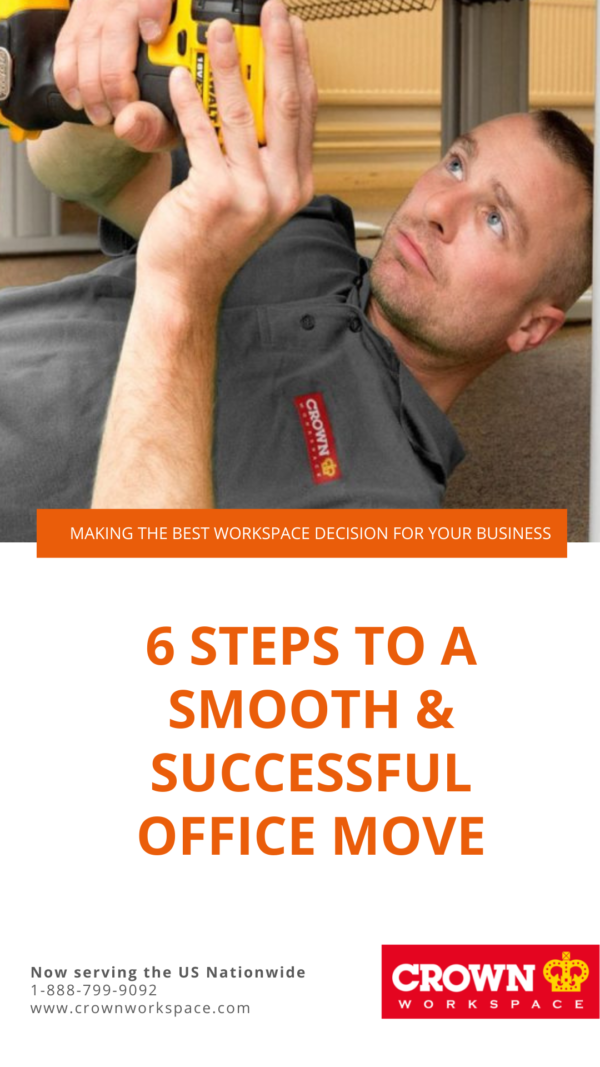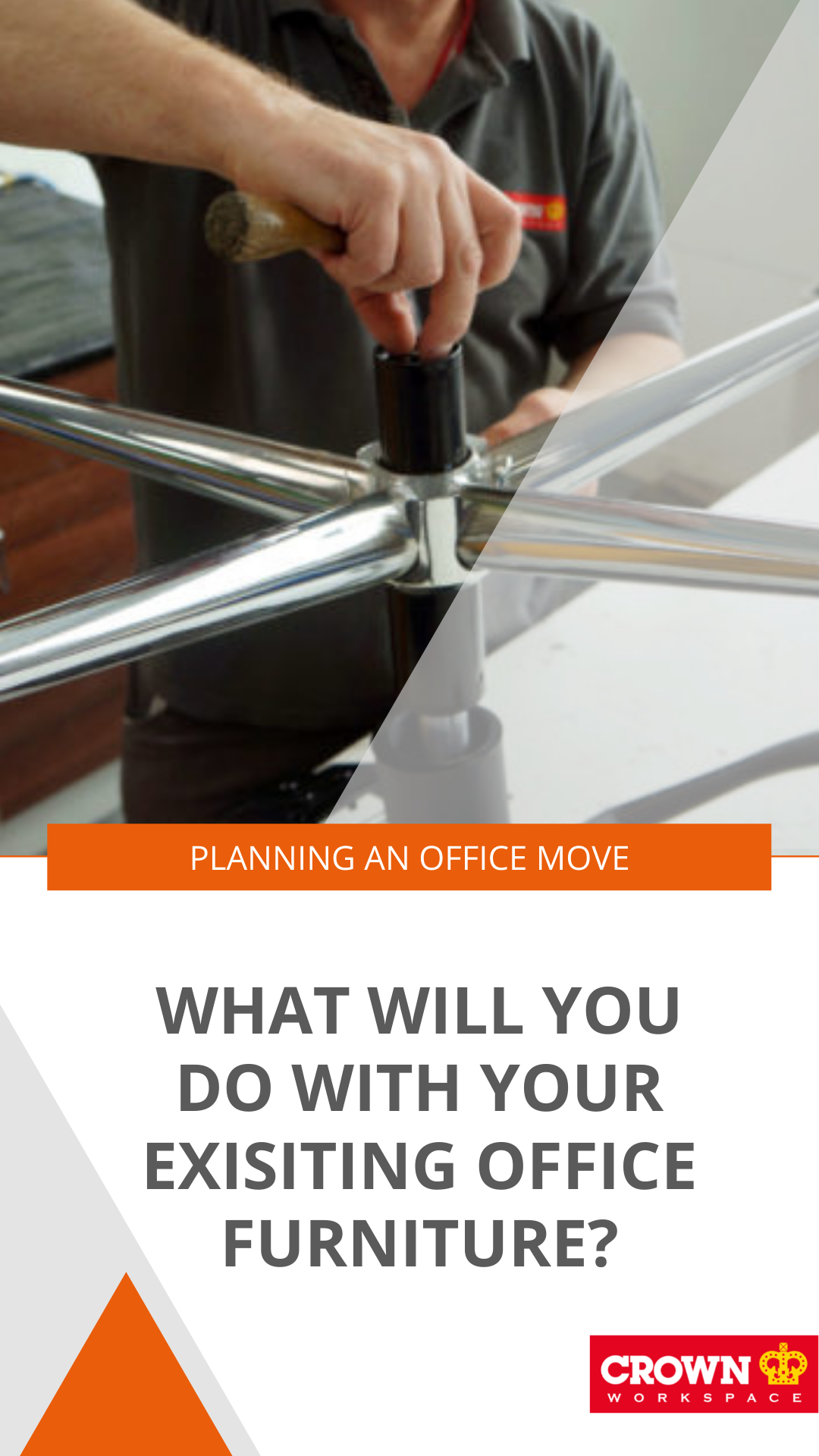6 Steps to a Smooth & Successful Office Move

It’s said that moving house is one of the most stressful things you can do in life, so it’s no surprise that moving office can be similarly stress-inducing. In fact, a study by E.ON reveals that the potential hassles involved have forced nearly 78% of business owners and managers to delay moving, meaning they stay in often ’cramped, dilapidated, expensive or inefficient buildings’.
More than a quarter of those managers worry about the costs and time involved with a move with a similar number, approximately 27% saying they didn’t know where to start. That’s where Crown Workspace can help by ensuring your business avoids the most costly mistakes of a relocation project.
We’ve put together 6 essential things you need to consider to
successfully manage an office relocation project:
-
Time Frame and Budget
-
Communication is Key
-
IT, Data, Computers and Connections
-
Interior Solutions and Office Design
-
Old Equipment and Furniture
-
Office Relocation Plan

1. Decide on time frame and budget
How much is your relocation project going to cost?
When moving offices, the costs can very quickly rack up. Budgets can be easily overshot simply due to delays, oversights, and issues cropping up unexpectedly. The project manager will likely be responsible for managing this budget which could include costs such as interior design and new stationery – but usually exclude legal and property fees.
Sticking to your budget can be equally as hard as actually setting it. Nasty surprises and hidden costs can crop up from things you may not have even thought of. Here are some common items that many budgets overlook:
- Have you considered the cost of dilapidations or reinstating the office you are vacating?
- Do you have any leased or specialist equipment that requires special handling? This could also include art collections or chemicals
- Are there any access or timing limitations that will impact the cost of your relocation?
It’s important that you can ascertain the full costs of your office relocation before you begin. Sizeable costs can be misjudged – or missed entirely – just because you haven’t experienced a move before. You may find it beneficial to discuss your move with an experienced office moving company who may be able to shed light on the full costs of your move!
2. Communication is key
Who needs to know that you are moving?
Effective communication is essential to the success of a relocation project. Although it may not be the facilities manager’s responsibility in every case, if it falls under your remit, it’s important to have a strategy in place to spread the word of your move.
Plan a detailed email, newsletter segment, town hall presentation, or brief video to tell employees about the big move.
Here are some items to include in your announcement:
- New office name and address
- Moving date/dates
- Key features of the new office
- Justification for the move (A quote from the CEO or other key decision maker is the perfect way to explain the decision to move—and even get them excited for the transition.)
- What employees need to do right now, if anything
- What future moving information employees should expect to receive
Notifying Your Employees
Frequently, the success of a relocation project is reliant upon the ‘soft’ elements of a move. Keeping employees on your side and in the loop is an important part of relieving any anxiety associated with moving office.
If you are moving to a completely new city. Employees often feel overwhelmed by the idea of relocating, which is understandable. Though companies traditionally grant two weeks to their employees to accept a relocation offer, this may not be enough time for employees to make a decision.
Listening to their concerns will also help you address some of the problems associated with moving and ensure that you’ve covered every base.
The presence of a neutral third party will allow your employees to feel like they have someone reliable to connect with throughout the relocation process. In fact, about 60 percent of companies utilize relocation specialists, like Crown World Mobility.
I.T. Department
Whether your IT department consists of one person, or you have a move management project manager who will do the majority of the work for you, it’s essential that you plan each detail of your office move precisely and far enough in advance. Moving IT equipment can be the most challenging and riskiest part of any office move.
Following our essential IT checklist will help you arrange and supervise your office move securely, effectively, and without interruptions in your services. This will save you time and money, as well as keep your staff and customers happy.
The Office Moving Company
Reach out to your moving company as early as possible. Once you reach out to Crown Workspace about your move, we’ll provide you with all the information you need to move successfully. To make sure no details slip through the cracks, communicate with the project managers on your office relocation regularly.
Your Service Providers
Make your service providers aware of your move as early as possible in the relocation project. You may have to serve notice periods on some of these, so reviewing your contracts and researching how to notify them formally is necessary.
TOP TIP
Don’t forget to let your bank and insurance companies know you’re moving! You may also want to let your old and new neighbors know your arrangements.
3. IT, Data, Computers and Connections
How will you relocate your electrical equipment and IT, or will you take the opportunity of the move to upgrade to new IT kit?
When considering relocating IT equipment, there’s no shortage of points that you need to consider. As they’re critical to the running of most modern businesses, it’s essential you take special steps to care of this equipment.
Desktops
Each of your colleagues’ setups will be unique, both in terms of configurations and screen equipment. Before moving, you will need to audit equipment setups to recommission equipment ready for use in your new office. Once these have been very carefully moved, they then need to be recommissioned and connected to sometimes complex network infrastructures. These systems host sensitive data that needs to remain secure, hence why it is essential you use CTC cleared engineers to recommission equipment.
Data Centers & Servers
Servers that host business-critical data need to be very carefully and safely relocated with downtime reduced to an absolute minimum. Migrations need to be seamless, secure, and optimally scheduled to minimize downtime.
Breakages, failure, or stolen data can be hugely expensive. It’s important that equipment is monitored in transportation and moved using specialist packaging to keep it safe and prevent static build-up.
Leased Equipment
For some of your equipment, you may need to request approval from your vendor before you can even move it or risk breaking warranty or service cover agreements. For some specialist equipment, the vendors themselves may insist upon moving it or if you are responsible for moving the leased equipment yourself, the vendor may require you to follow an approved moving process. Your obligations when relocating leased equipment should be detailed in your contract documentation.
Telephones and Internet Connections
IT and telecommunications are the lifeblood of any company. If your systems aren’t working and your phones aren’t ringing in your new office then you can’t operate. With increasing telecom deregulation, new offerings are constantly becoming available – so make sure you shop around for the right phone system and service contract that best suit your requirements Consider what kind of growth or expansion you expect in the next 3-5 years; this will help determine whether you should consider a new business phone system for your new office location.
- Review line capacity to determine whether you need to order new phone lines.
- Set up call forwarding if you’re changing your phone number.
- Establish and order the type of internet access required for the new location.
- An office move is an ideal time to review telecommunication requirements. If you are expanding the office set-up then consider moving from traditional phone line to Voice over Internet Protocol (VoIP). If you are already using VoIP, ensure bandwidth requirements are met for a fast internet connectivity.
- Installation of internet and telephone line can take some time. Ensure internet and phone lines are installed, tested and function well in advance of the moving day.
Get our Essential IT Checklist for your office move here

4. Interior Solutions and Office Design
How should you design your new office space?
Moving office is a fantastic opportunity to really think about your long term business objectives and sculpt how your clients and customers perceive you, building a stronger corporate identity and providing an environment that employees will feel proud to work in.
Depending on the state of your new workspace, it may need substantial refurbishment or a little bit of touching up. Either way, you will need to find an office fit-out company that will provide you with the interior solutions you need – ideally, a company that provides a turnkey solution while delivering in terms of timeline, a high standard of finish and within your budget.
Before you start to look into current office trends and design concepts it’s important to create an office relocation plan, during the design phase of your move the following areas should be addressed:
Space Planning
Space Planning involves much more than sketching a preliminary floor plan. The design team must first take into consideration any codes and regulations (statutory requirements), lighting, teaming requirements, inter-communication, and storage to make the best possible use of available space.
Office Design
One of the most important questions you should ask yourself when discussing the design of your new office is, ‘what is this office for?’ Do you want to impress clients, build a more collaborative and productive environment for staff, or stage the future developments of an expanding team? Lots to consider, but with these questions answered your design team can start to create an office environment that reflects your business objectives and brand values, whilst staying on budget
Office Fit-out
This encompasses the physical office fit-out and includes the entire off and on-site work to produce the agreed workspace environment – such as the flooring, walls, ceilings, partitioning, decoration, fixtures and fittings, and the installation of electrical and mechanical services.
Designing the Post-Covid Adaptive Workplace
Where we do work has changed in the past year and a half. Making sure that employees are engaged at work is an important aspect to any office design. According to a Deloitte study, employee engagement overall tends to be at its highest among employees who work remotely 60–80% of the time. And, according to a Gallup poll, teams with high employee engagement rates are 21% more productive.
Adaptive workplaces could become even more attractive in a post-pandemic world when situations involving dependent and childcare normalize, and social isolation is minimized.
There are four aspects to keep in mind while designing adaptive workplaces:
- Places and Spaces: understand the work people do and where they’re most engaged doing it.
- Productivity and performance: look at the science and psychology of work behavior.
- Well-being and connection: listen to your workforce
- Workforce experience: adapt organization process to meet hybrid work needs.
Having a project manager by your side for the duration of designing your office space will help to achieve everything you are look for, from aesthetics to employee engagement and productivity.

5. Office Furniture and Old Equipment
What will you do with your existing office furniture?
When it comes to office furniture, it’s not unreasonable to think that you have choices: one, you take it with you to your new location, or two, replace it with entirely new furniture. However, you may be able to achieve the benefits of both by refurbishing or remanufacturing your office furniture.
An integrated services provider should be able to provide you with a range of options for your old furniture. They may have the capacity to turnaround office furniture remanufacturing projects quickly and provide you with other options for your old furniture, like marketing or selling it on your behalf.
What will you do with your unwanted furniture or IT equipment?
Relocating offices is a great opportunity to declutter, sort old files and get rid of redundant furniture and legacy IT equipment. There’s little point spending time/budget on moving anything you are not going to use.
Yet, disposing of these items can prove expensive. If you have unwanted furniture, IT or electrical equipment, there are easy ways you can responsibly and sustainably clear these items, saving you disposal costs and preventing waste. If you choose to use a sustainable clearance provider, then they can donate office furniture, IT, and electrical equipment or even resell items that you no longer need. If items cannot be reused effectively secure recycling will still make sure costs are reduced.
6. Office Relocation Plan
Have you got the resources you need to pull off a seamless move?
Whether you are working with an integrated office moving service provider or simply a removal company, having a structured moving plan is critical to ensure as little disruption to business as possible.
Integrated services providers will provide you with the knowledge, expertise, and resources you need to ensure the move is carried out to high standards. Additionally, they will provide support before, during, and after your move, giving you the help you need to minimize disruptions.
This can include providing packing and unpacking services to help ensure everything is transferred safely to the correct location, furniture dismantling, and reassembly, cleaning of existing and new areas, and manning of help desks.
Once you’ve completed the move with as little disruption as possible, take the time to celebrate with a move-in party for staff and clients!
Reach out to us whenever you need assistance or a second opinion on your office move.
Related stories
Financial institution completes IT upgrade across three North American sites The Company’s Challenge Our client, a multinational financial institution, required shipping and installation of upgraded IT equipment for hundreds of workstations across three remote offices – in Chicago, Boston, and Toronto – where they had limited internal support. This needed to happen in a short […]
For any organization, changing location needs careful planning and execution. But for some companies the nature of their business means they need something more tailored than the average office move. For example, hospitals, galleries, laboratories, and factories will require specialists to ensure business continuity and the safe transfer of highly sensitive and valuable equipment. Industrial […]
Announcing that you’re going to move offices is a huge part of a smooth relocation process. Whether it’s a small to medium enterprise, or a larger multinational – getting it right is essential for both your staff and clients alike. The reasons why it’s essential to make a moving office announcement Office relocation has […]



















